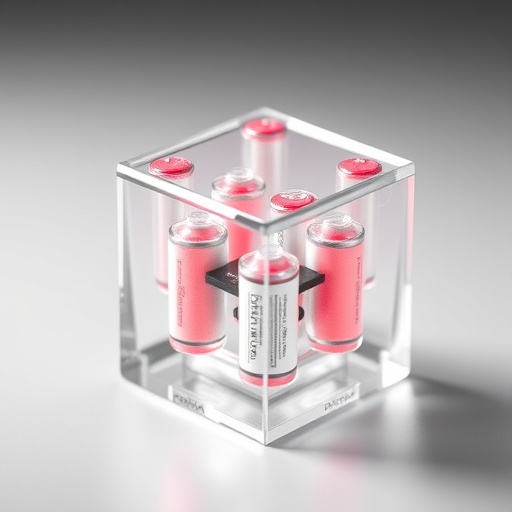Recent advancements in energy storage technologies have led researchers to explore innovative materials that can enhance the efficiency and safety of batteries. One such development is the identification of suitable electrolyte materials for magnesium-ion batteries, which promise to elevate battery performance while minimizing environmental impact. A pioneering study led by N.M.M. Sarangika, M.A.K.L. Dissanayake, and G.K.R. Senadeera delves into the intricacies of developing a quasi-solid-state electrolyte composed of polyethylene oxide and magnesium triflate, tailored for rechargeable magnesium-ion battery applications.
Magnesium-ion batteries present several advantages over their lithium-ion counterparts, including higher theoretical energy density, lower cost, and improved safety features. Despite these benefits, the development of effective electrolyte materials remains a challenge. Conventional liquid electrolytes can pose safety hazards and lead to performance degradation. Hence, researchers have shifted their focus toward more stable solid-state or quasi-solid-state electrolytes that minimize these risks while maintaining desirable ionic conductivity.
In the study, the researchers synthesized a Mg++ ion-conducting quasi-solid-state electrolyte utilizing polyethylene oxide blended with magnesium triflate. Polyethylene oxide, a polymer with excellent film-forming capabilities, serves as an ideal matrix for the incorporation of ionic salts. By combining polyethylene oxide with magnesium triflate, which is known for its high ionic conductivity, the researchers aimed to create a stable electrolyte with significant ion transport characteristics.
.adsslot_sPmDXG4NSp{ width:728px !important; height:90px !important; }
@media (max-width:1199px) { .adsslot_sPmDXG4NSp{ width:468px !important; height:60px !important; } }
@media (max-width:767px) { .adsslot_sPmDXG4NSp{ width:320px !important; height:50px !important; } }
ADVERTISEMENT
The methodology employed in this research involved systematic experimentation, varying concentrations of magnesium triflate within the polyethylene oxide matrix. Through precise control of the polymer to salt ratio, the team was able to optimize the ionic conductivity of the resulting electrolyte. The performance of the electrolyte was meticulously evaluated under various ambient conditions to ascertain its stability and effectiveness in a battery setup.
One of the standout findings of this research was the substantial enhancement in ionic conductivity observed at specific concentrations of magnesium triflate. The study revealed that a finely-tuned ratio of polyethylene oxide to magnesium triflate yielded an electrolyte with exceptional ion transport properties, making it a promising candidate for use in rechargeable magnesium-ion batteries. This breakthrough marks a significant stride toward developing safer and more efficient energy storage systems.
Another critical aspect addressed in the study was the thermal stability of the synthesized electrolyte. Unlike traditional liquid electrolytes that can evaporate or decompose at elevated temperatures, the quasi-solid-state configuration exhibited remarkable thermal stability. This characteristic is particularly valuable in battery applications where heat dissipation could pose a risk to safety and performance, making this technology suitable for a wide range of operating conditions.
The researchers also investigated the compatibility of the quasi-solid-state electrolyte with typical anode and cathode materials used in magnesium-ion batteries. By employing a series of material characterization techniques, the team assessed the interface behavior, which is pivotal for ensuring the efficiency of the electrochemical reactions driving the battery performance. Their findings indicated that the synthesized electrolyte maintained good interfacial stability, further validating its potential for commercial applications.
Despite the promising results, the study acknowledged the existing challenges in scaling up the production of such electrolytes. The researchers emphasized the importance of developing cost-effective manufacturing processes as a critical step in facilitating broader adoption of magnesium-ion battery technology. As the demand for energy storage solutions continues to grow, addressing these economic aspects will be crucial for the commercialization of these innovative battery systems.
Looking ahead, the implications of this research extend beyond magnesium-ion batteries. The materials and methodologies explored can serve as foundational building blocks for future electrolyte developments across various battery chemistries. The quest for more efficient, safer, and environmentally friendly energy storage solutions remains a priority for researchers and industry stakeholders alike.
In conclusion, the pioneering work of Sarangika, Dissanayake, and Senadeera marks a significant advancement in the exploration of magnesium-ion battery technology. By developing a novel quasi-solid-state electrolyte based on polyethylene oxide and magnesium triflate, the researchers have opened new avenues for enhancing battery performance. As the field of energy storage continues to evolve, such innovations hold the potential to redefine our approaches to sustainable energy technologies, bringing us closer to a future powered by efficient, reliable, and environmentally friendly battery systems.
As we delve deeper into the implications of this research, it becomes apparent that the energy landscape is on the brink of transformative changes. With ongoing efforts to optimize these new materials and adapt them for various applications, the potential impact on energy storage solutions globally is immense. The quest for efficient and safer battery technologies warrants continuing investment in research and development, ensuring that we harness the full capabilities of emerging materials science.
This study serves as a catalyst for further investigations into magnesium-ion batteries, encouraging a collaborative approach among researchers dedicated to overcoming existing hurdles in battery technology. By working together, the scientific community can accelerate the development and commercialization of next-generation energy storage systems that meet the growing demands of a sustainable future.
Subject of Research: Quasi-solid-state electrolytes for magnesium-ion batteries.
Article Title: Mg++ ion conducting polyethylene oxide/magnesium triflate quasi-solid state electrolyte for rechargeable Mg++ battery application.
Article References:
Sarangika, H.N.M., Dissanayake, M.A.K.L. & Senadeera, G.K.R. Mg++ ion conducting polyethylene oxide/magnesium triflate quasi-solid state electrolyte for rechargeable Mg++ battery application.
Ionics (2025). https://doi.org/10.1007/s11581-025-06536-2
Image Credits: AI Generated
DOI: https://doi.org/10.1007/s11581-025-06536-2
Keywords: Magnesium-ion batteries, quasi-solid-state electrolyte, polyethylene oxide, magnesium triflate, ion conductivity, energy storage systems.
Tags: eco-friendly battery materialshigh energy density batteriesimproved battery safety featuresinnovative energy storage technologiesionic conductivity in electrolytesmagnesium triflate applicationsmagnesium-ion batteriespolyethylene oxide electrolytespolymer-based battery solutionsquasi-solid-state electrolytesrechargeable battery advancementssolid-state battery development





